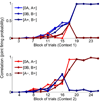Attractor concretion as a mechanism for the formation of context representations
- PMID: 20100580
- PMCID: PMC2891574
- DOI: 10.1016/j.neuroimage.2010.01.047
Attractor concretion as a mechanism for the formation of context representations
Abstract
Complex tasks often require the memory of recent events, the knowledge about the context in which they occur, and the goals we intend to reach. All this information is stored in our mental states. Given a set of mental states, reinforcement learning (RL) algorithms predict the optimal policy that maximizes future reward. RL algorithms assign a value to each already-known state so that discovering the optimal policy reduces to selecting the action leading to the state with the highest value. But how does the brain create representations of these mental states in the first place? We propose a mechanism for the creation of mental states that contain information about the temporal statistics of the events in a particular context. We suggest that the mental states are represented by stable patterns of reverberating activity, which are attractors of the neural dynamics. These representations are built from neurons that are selective to specific combinations of external events (e.g. sensory stimuli) and pre-existent mental states. Consistent with this notion, we find that neurons in the amygdala and in orbitofrontal cortex (OFC) often exhibit this form of mixed selectivity. We propose that activating different mixed selectivity neurons in a fixed temporal order modifies synaptic connections so that conjunctions of events and mental states merge into a single pattern of reverberating activity. This process corresponds to the birth of a new, different mental state that encodes a different temporal context. The concretion process depends on temporal contiguity, i.e. on the probability that a combination of an event and mental states follows or precedes the events and states that define a certain context. The information contained in the context thereby allows an animal to assign unambiguously a value to the events that initially appeared in different situations with different meanings.
Copyright (c) 2010 Elsevier Inc. All rights reserved.
Figures










Similar articles
-
[Dynamic paradigm in psychopathology: "chaos theory", from physics to psychiatry].Encephale. 2001 May-Jun;27(3):260-8. Encephale. 2001. PMID: 11488256 French.
-
Hebbian learning of context in recurrent neural networks.Neural Comput. 1996 Nov 15;8(8):1677-710. doi: 10.1162/neco.1996.8.8.1677. Neural Comput. 1996. PMID: 8888613
-
Neural representation of behavioral outcomes in the orbitofrontal cortex.Curr Opin Neurobiol. 2009 Feb;19(1):84-91. doi: 10.1016/j.conb.2009.03.010. Epub 2009 May 6. Curr Opin Neurobiol. 2009. PMID: 19427193 Review.
-
A neural network model for the orbitofrontal cortex and task space acquisition during reinforcement learning.PLoS Comput Biol. 2018 Jan 4;14(1):e1005925. doi: 10.1371/journal.pcbi.1005925. eCollection 2018 Jan. PLoS Comput Biol. 2018. PMID: 29300746 Free PMC article.
-
Reward-dependent learning in neuronal networks for planning and decision making.Prog Brain Res. 2000;126:217-29. doi: 10.1016/S0079-6123(00)26016-0. Prog Brain Res. 2000. PMID: 11105649 Review.
Cited by
-
The sparseness of mixed selectivity neurons controls the generalization-discrimination trade-off.J Neurosci. 2013 Feb 27;33(9):3844-56. doi: 10.1523/JNEUROSCI.2753-12.2013. J Neurosci. 2013. PMID: 23447596 Free PMC article.
-
Spatiotemporal discrimination in attractor networks with short-term synaptic plasticity.J Comput Neurosci. 2019 Jun;46(3):279-297. doi: 10.1007/s10827-019-00717-5. Epub 2019 May 27. J Comput Neurosci. 2019. PMID: 31134433 Free PMC article.
-
Synaptic plasticity and connectivity requirements to produce stimulus-pair specific responses in recurrent networks of spiking neurons.PLoS Comput Biol. 2011 Feb;7(2):e1001091. doi: 10.1371/journal.pcbi.1001091. Epub 2011 Feb 24. PLoS Comput Biol. 2011. PMID: 21390275 Free PMC article.
-
Fast updating feedback from piriform cortex to the olfactory bulb relays multimodal reward contingency signals during rule-reversal.bioRxiv [Preprint]. 2023 Sep 13:2023.09.12.557267. doi: 10.1101/2023.09.12.557267. bioRxiv. 2023. Update in: Nat Commun. 2025 Jan 22;16(1):937. doi: 10.1038/s41467-025-56023-5. PMID: 37745564 Free PMC article. Updated. Preprint.
-
Fear conditioning and extinction: emotional states encoded by distinct signaling pathways.Trends Neurosci. 2012 Mar;35(3):145-55. doi: 10.1016/j.tins.2011.10.003. Epub 2011 Nov 25. Trends Neurosci. 2012. PMID: 22118930 Free PMC article. Review.
References
-
- Amit D, Brunel N. Learning internal representations in an attractor neural network with analogue neurons. Network: Computation in Neural Systems. 1995;6(3):359–388.
-
- Amit DJ. Modeling Brain Function. Cambridge University Press; 1989.
-
- Asaad WF, Rainer G, Miller EK. Neural activity in the primate prefrontal cortex during associative learning. Neuron. 1998;21(6):1399–1407. - PubMed
Publication types
MeSH terms
Grants and funding
LinkOut - more resources
Full Text Sources

